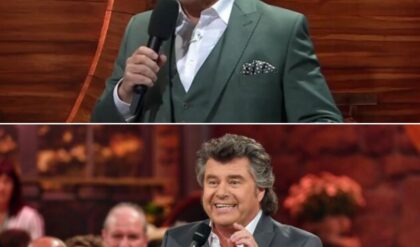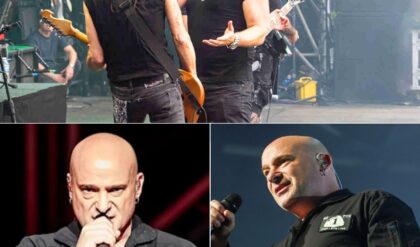
The USS Massachusetts (BB-59), one of the fast battleships of the South Dakota-class, was built under the limitations enforced by the Washington and London naval treaties. As with the other vessels in her class, her size was governed by weight limits. She still managed to maintain effective armor protection and firepower, but this resulted in a very cramped ship.
Regardless, Massachusetts, nicknamed “Big Mamie,” and the rest of the South Dakota-class were among the few ships to try and achieve many different things at once and succeed.
Before the South Dakota-class, there was the North Carolina-class
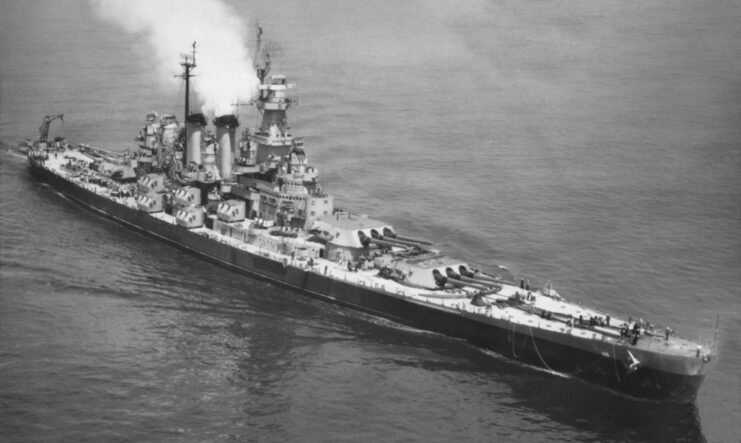
USS North Carolina (BB-55), 1946. (Photo Credit: USN / David Buell / NavSource / Wikimedia Commons / Public Domain)
The South Dakota-class was the successor to the two-vessel North Carolina-class, which was also governed by the regulations set out by the Washington and London naval treaties, restricting battleships to a displacement of 36,000 tons and a main battery of 14-inch guns. While these agreements were intended to stop a naval arms race, they had designers struggling to create ships that could provide adequate protection, firepower and speed. In many cases, one of these had to be pushed aside.
While more North Carolina-class vessels were desired, it was decided, instead, that a similar but separate class be developed – enter the South Dakota-class fast battleships.
South Dakota-class fast battleships

USS South Dakota (BB-57), 1943. (Photo Credit: Unknown Author / US Navy / Wikimedia Commons / Public Domain)
Thanks to the “escalator clause” in the Second London Treaty, the United States was able to arm both the North Carolina– and South Dakota-class vessels with powerful 16-inch guns. While the latter were slightly smaller than their predecessors, they had more armor. Essentially, they were a small, more protected version of the North Carolina-class ships.
Four South Dakota-class ships were constructed: the USS South Dakota (BB-57), Indiana (BB-58), Massachusetts and Alabama (BB-60).
USS Massachusetts (BB-39) specs
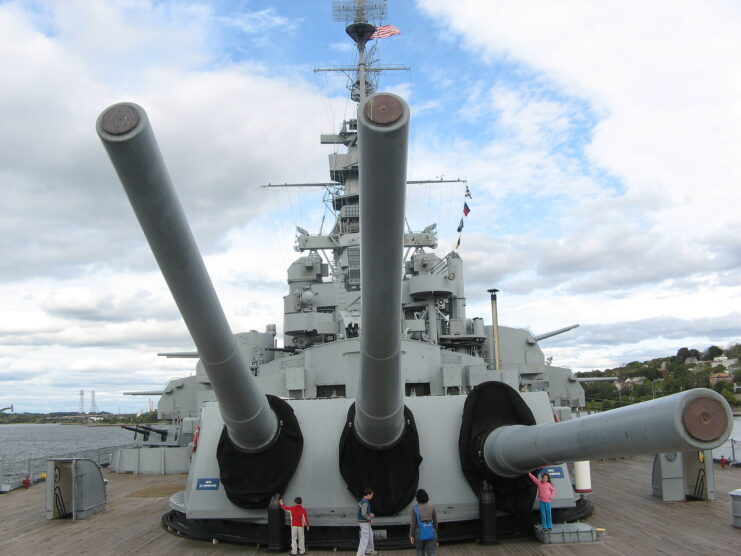
Rear turret of the USS Massachusetts (BB-59), 2009. (Photo Credit: Somone35 / Wikimedia Commons CC BY-SA 3.0)
The USS Massachusetts was powered by four General Electric steam turbines, four screw propellers, and eight Babcock & Wilcox boilers, allowing the vessel to reach 31.6 MPH and travel 15,000 nautical miles. As aforementioned, it was heavily armored, with 12.2 inches around the belt, 18 inches around the turrets and six inches across the deck.
In terms of armament, the fast battleship was equipped with nine 16-inch .45-caliber Mk 6 guns in three triple-gun turrets; 20 five-inch .38-caliber dual-purpose (DP) guns in twin turrets; seven Bofors 40 mm anti-aircraft guns in quad mounts; and thirty-five 20 mm Oerlikon cannons. For observation missions, she could also launch three Vought OS2U Kingfisher floatplanes.
USS Massachusetts (BB-59) in North Africa

USS Massachusetts (BB-59) underway, 1944. (Photo Credit: USN / World War II Cruise Book / Wikimedia Commons / Public Domain)
The third ship in her class, the USS Massachusetts was commissioned on May 12, 1942, joining the Western Naval Task Force just in time for service off the coast of North Africa. Once she’d joined as the flagship of Task Group (TG) 34.1, she became involved in the Naval Battle of Casablanca, which saw American ships engage with enemy submarines, coastal guns and warships operated by Vichy France.
On November 8, 1942, the USS Wichita (CA-45) and Tuscaloosa (CA-37) dealt with the coastal defenses at Casablanca, while the crew of Massachusetts engaged the incomplete French battleship Jean Bart (1940), anchored at the port and with only half of her main battery installed. Striking the vessel with five hits amid a heavy defense from nearby vessels, the fast battleship also suffered strikes, becoming one of the first vessels to be shot at the Americans in the fight against Germany.
A ceasefire was agreed upon on November 11.
Transferring to the Pacific Theater
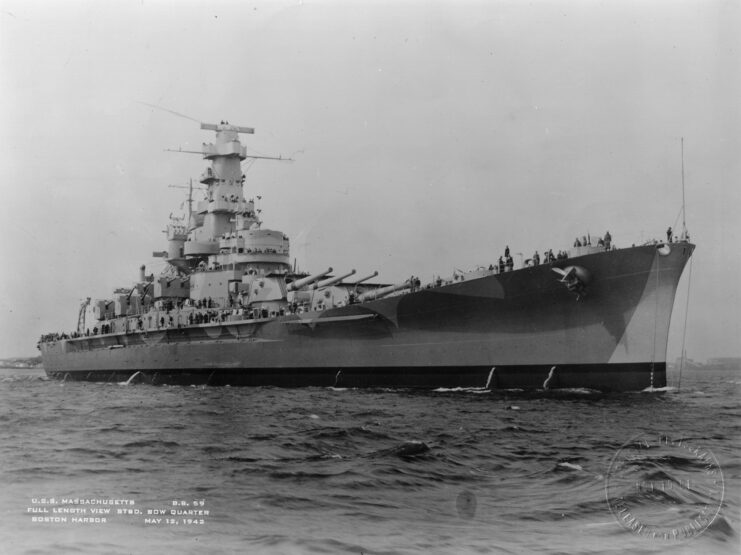
USS Massachusetts (BB-59), 1942. (Photo Credit: United States Navy / NavSource / Wikimedia Commons / Public Domain)
With these threats dealt with, the USS Massachusetts was needed in the Pacific Theater. She arrived in New Caledonia in March 1943 and quickly got to work as a convoy escort near the Solomon Islands. She spent the rest of the war in the Pacific, serving as a carrier and convoy escort for the Fast Carrier Task Force. The fast battleship also took part in shore bombardments.
Toward the end of the year, Massachusetts was involved in the Gilbert and Marshall Islands Campaign, softening up the Japanese positions on the small islands, and she later took part in the Philippines Campaign of 1944-45. Before and between these actions, she protected carriers against air and surface attacks, with her very capable anti-aircraft defenses proving to be extremely useful.
Later on, Massachusetts was involved in operations on Formosa, Iwo Jima and Okinawa. Despite constant kamikaze attacks, she managed to come out unscathed. She even made it through Typhoon Cobra with only a single crewman injured. Her final mission in the conflict was bombarding industrial targets at Hamamatsu. During this, she was joined by the British battleship HMS King George V (41). It was at this time that many believe Massachusetts fired the last 16-inch shell of World War II.
Stricken from the Naval Vessel Register

USS Massachusetts (BB-59) being towed to Battleship Cove, Fall River, Massachusetts, 1965. (Photo Credit: U.S. Department of Defense / U.S. Navy All Hands Magazine / Wikimedia Commons / Public Domain)
When the war ended, the USS Massachusetts returned to the United States and underwent an overhaul, which was completed by early 1946. She then spent time along the West Coast, before returning to the Atlantic.
On March 27, 1947, she was officially decommissioned in Norfolk, Virginia, and placed in the Atlantic Reserve Fleet. As with other veteran ships from the Second World War, research was conducted to determine whether she could be converted into something else, but this never materialized. She was stricken from the Naval Vessel Register on June 1, 1962.
Thankfully, Massachusetts was saved from the scrap heap through efforts by her former crew and a group of children and is, today, preserved as a museum ship at Battleship Cove, Fall River, Massachusetts. The only change that’s been made since her decommissioning was the removal of materials for use in recommissioning the famed Iowa-class battleships.
